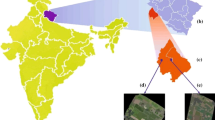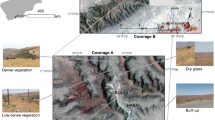Abstract
Significant efforts have been made recently in the application of high-resolution remote sensing imagery (i.e., sub-meter) captured by unmanned aerial vehicles (UAVs) for precision agricultural applications for high-value crops such as wine grapes. However, at such high resolution, shadows will appear in the optical imagery effectively reducing the reflectance and emission signal received by imaging sensors. To date, research that evaluates procedures to identify the occurrence of shadows in imagery produced by UAVs is limited. In this study, the performance of four different shadow detection methods used in satellite imagery was evaluated for high-resolution UAV imagery collected over a California vineyard during the Grape Remote sensing Atmospheric Profile and Evapotranspiration eXperiment (GRAPEX) field campaigns. The performance of the shadow detection methods was compared and impacts of shadowed areas on the normalized difference vegetation index (NDVI) and estimated evapotranspiration (ET) using the Two-Source Energy Balance (TSEB) model are presented. The results indicated that two of the shadow detection methods, the supervised classification and index-based methods, had better performance than two other methods. Furthermore, assessment of shadowed pixels in the vine canopy led to significant differences in the calculated NDVI and ET in areas affected by shadows in the high-resolution imagery. Shadows are shown to have the greatest impact on modeled soil heat flux, while net radiation and sensible heat flux are less affected. Shadows also have an impact on the modeled Bowen ratio (ratio of sensible to latent heat) which can be used as an indicator of vine stress level.
















Similar content being viewed by others
References
AgiSoft LLC (2016) and Russia St Petersburg. Agisoft photoscan. Professional Edition
Anderson MC, Neale CMU, Li F, Norman JM, Kustas WP, Jayanthi H, Chavez J (2004) Upscaling ground observations of vegetation water content, canopy height, and leaf area index during SMEX02 using aircraft and Landsat imagery. Rem Sens Environ 92:447–464
Bethsda MD (1997) Manual of photographic interpretation. 2nd edition, American Society Photogrammetry and remote sensing (ASPRS)
Congalton RG (1991) A review of assessing the accuracy of classifications of remotely sensed data. Rem Sens Environ 37(1):35–46
Campbell GS, Norman JM (1998) An introduction to environmental biophysics. Springer, New York
Carlson TN, Ripley DA (1997) On the relation between NDVI, fractional vegetation cover, and leaf area index. Rem Sens Environ 62(3):241–252
Choi H, Bindschadler R (2004) Cloud detection in Landsat imagery of ice sheets using shadow matching technique and automatic normalized difference snow index threshold value decision. Rem Sens Environ 91(2):237–242
Crowther BG (1992) Radiometric calibration of multispectral video imagery. Doctoral dissertation. State University. Department of biological and Irrigation Engineering, Utah
Elarab M, Ticlavilca AM, Torres-Rua AF, Maslova I, McKee M (2015) Estimating chlorophyll with thermal and broadband multispectral high resolution imagery from an unmanned aerial system using relevance vector machines for precision agriculture. Int J Appl Earth Obs Geoinform 43:32–42
Fuentes S, Poblete-Echeverra C, Ortega-Farias S, Tyerman S, De Bei R (2014) Automated estimation of leaf area index from grapevine canopies using cover photography video and computational analysis methods. Aust J Grape Wine Res 20(3):465–473
Gonzalez RC, Woods RE, Eddins SL (2004) Digital image processing using. MATLAB, Prentice Hall
Hsieh YT, Wu ST, Chen CT, Chen JC (2016) Analyzing spectral characteristics of shadow area from ADS-40 high radiometric resolution aerial images. Int Arch Photogram, Rem Sens Spatial Inf Sci XLI–B7:223–227
Huang J, Chen C (2009a) A physical approach to moving cast shadow detection. IEEE international conference on acoustics, speech and signal processing, 769–772
Huang J, Chen C (2009b) Moving cast shadow detection using physics-based features. IEEE conference on computer vision and pattern recognition, 2310–2317
Kiran TS (2016) A framework in shadow detection and compensation of images. DJ J Adv Electron Commun Eng 2(3):1–9
Kumar P, Sengupta K, Lee A (2002) A comparative study of different color spaces for foreground and shadow detection for traffic monitoring system. In: The IEEE 5th International Conference on Intelligent Transportation Systems, 100–105
Kustas WP, Norman JM (1999) Evaluation of soil and vegetation heat flux predictions using a simple two-source model with radiometric temperatures for partial canopy cover. Agric For Meteorol 94(1):13–29. https://doi.org/10.1016/S0168-1923(99)00005-2
Kustas WP, Anderson MC, Alfieri JG, Knipper K, Torres-Rua A, Parry CK, Hieto H, Agam N, White A, Gao F, McKee L, Prueger JH, Hipps LE, Los S, Alsina M, Sanchez L, Sams B, Dokoozlian N, McKee M, Jones S, Yang Y, Wilson TG, Lei F, McElrone A, Heitman JL, Howard AM, Post K, Melton F, Hain C (2018) The Grape Remote sensing Atmospheric Profile and Evapotranspiration eXperiment (GRAPEX). Bull Am Meteorol Soc. https://doi.org/10.1175/BAMS-D-16-0244.1
Leblon B, Gallant L, Charland SD (1996a) Shadowing effects on SPOT-HRV and high spectral resolution reflectance in Christmas tree plantation. Int J Rem Sens 17(2):277–289
Leblon B, Gallant L, Grandberg H (1996b) Effects of shadowing types on ground-measured visible and near-infrared shadow reflectance. Rem Sens Environ 58(3):322–328
Lillesand TM, Kiefer RW (2000) Remote sensing and image interpretation, 4th edn. New York, Wiley
Miura T, Huete AR (2009) Performance of three reflectance calibration methods for airborne hyperspectral spectrometer data. Sensors 9(2):794–813
MosaicMill Oy (2009) EnsoMOSAIC image processing users guide. Version 7.3. Mosaic Mill Ltd. Finland
Cook BD, Corp LW, Nelson RF, Middleton EM, Morton DC, McCorkel JT, Masek JG, Ranson KJ, Ly V, Montesano PM (2013) NASA Goddard’s lidar, hyperspectral and thermal (G-LiHT) airborne imager. Rem Sens 5:4045–4066. https://doi.org/10.3390/rs5084045
Neale CM, Crowther BG (1994) An airborne multispectral video/radiometer remote sensing system: development and calibration. Rem Sens Environ 49(3):187–194
Nemani RR, Running SW (1989) Estimation of regional surface resistance to evapotranspiration from NDVI and thermal IR AVHRR data. J Appl Meteorol 28(4):276–284
Nieto H, Kustas W, Torres-Rua A, Alfieri J, Gao F, Anderson M, White WA, Song L, Mar Alsina M, Prueger J, McKee M, Elarab M, McKee L (2018) Evaluation of TSEB turbulent fluxes using different methods for the retrieval of soil and canopy component temperatures from UAV thermal and multispectral imagery. Irrigation Sci. https://doi.org/10.1007/s00271-018-0585-9
Norman JM, Kustas WP, Humes KS (1995) Source approach for estimating soil and vegetation energy fluxes in observations of directional radiometric surface temperature. Agric For Meteorol 77:263–293
Ortega-Farías S, Ortega-Salazar S, Poblete T, Kilic A, Allen R, Poblete-Echeverra C, Ahumada-Orellana L, Zuiga M, Seplveda D (2016) Estimation of energy balance components over a drip-irrigated olive orchard using thermal and multispectral cameras placed on a helicopter-based unmanned aerial vehicle (uav). Rem Sens 8(8)
Parry C, Nieto H, Guillevic P, Agam N, Kustas B, Alfieri J, McKee L, McElrone AJ. An intercomparison of radiation partitioning models in vineyard row structured canopies. Irrigation Sci (In press)
Poblete T, Ortega-Farías S, Ryu D (2018) Automatic coregistration algorithm to remove canopy shaded pixels in UAV-borne thermal images to improve the estimation of crop water stress index of a drip-irrigated cabernet sauvignon vineyard. Sensors 18(2):397
Priestley CHB, Taylor RJ (1972) On the assessment of surface heat flux and evaporation using large-scale parameters. Mon Weather Rev 100:81–92
Qiao X, Yuan D, Li H (2017) Urban shadow detection and classification using hyperspectral image. J Indian Soc Rem Sens. https://doi.org/10.1007/s12524-016-0649-3
Ranson KJ, Daughtry CST (1987) Scene shadow effects on multispectral response. IEEE Trans Geosci Rem Sens 25(4):502–509
Rosin PL, Ellis T (1995) Image difference threshold strategies and shadow detection. Br Conf Mach Vision 1:347–356
Ross J (1981) The radiation regime and architecture of plants. In: Lieth H (ed) Tasks for Vegetation Sciences 3. Dr. W. Junk, The Hague, Netherlands
Sandnes FE (2011) Determining the geographical location of image scenes based object shadow lengths. J Signal Process Syst 65(1):35–47
Sanin A, Sanderson C, Lovell B (2012) Shadow detection: a survey and comparative evaluation of recent methods. Pattern Recognit 45(4):1684–1689
Scanlan JM, Chabries DM, Christiansen R (1990) A shadow detection and removal algorithm for 2-d images.In: Proceeding IEEE International Conference on Acoustics, Speech, and Signal Processing (ICASSP), pp 2057–2060
Shiting W, Hong Z (2013) Clustering-based shadow edge detection in a single color image. International Conference on Mechatronic Sciences, Electric Engineering and Computer (MEC), pp 1038–1041
Siala K, Chakchouk M, Besbes O, Chaieb F (2004) Moving shadow detection with support vector domain description in the color ratios space. In: Proceedings of the 17th IEEE International Conference on Pattern Recognition, pp 384–387
Sirmacek B, Unsalan C (2008) Building detection from aerial images using invariant color features and shadow information.” Proceedings of the 23rd International Symposium on Computer and Information Sciences (ISCIS 2008), Istanbul, Turkey, October 27–29, pp 1–5
Tolt G, Shimoni M, Ahlberg J, (2011) A shadow detection method for remote sensing images using VHR hyperspectral and LIDAR data. In: Proceedings of Geoscience and Remote Sensing Symposium, IGARSS, Vancouver Canada, pp 4423–4426
Torres-Rua A (2017) Vicarious calibration of sUAS microbolometer temperature imagery for estimation of radiometric land surface temperature. Sensors 17:1499
Trout TJ, Johnson LF (2007) Estimating crop water use from remotely sensed NDVI, crop models, and reference ET. USCID Fourth International Conference on Irrigation and Drainage, Sacramento, California, pp 275–285
Xia H, Chen X, Guo PA (2009) Shadow detection method for remote sensing images using affinity propagation algorithm. In: Proceedings of the IEEE International Conference on Systems, Man and Cybernetics, San Antonio, TX, USA, pp 5–8
Zhu Z, Woodcock CE (2012) Object-based cloud and cloud shadow detection in Landsat imagery. Rem Sens Environ 118(15):83–94
Acknowledgements
This project was financially supported under Cooperative Agreement no. 58-8042-7-006 from the U.S. Department of Agriculture, from NASA Applied Sciences-Water Resources Program under Award no. 200906 NNX17AF51G, and by the Utah Water Research Laboratory at Utah State University. The authors wish to thank E&J Gallo Winery for their continued collaborative support for this research, and the AggieAir UAV Remote Sensing Group at the Utah Water Research Laboratory for their UAV technology and skill and hard work in acquiring the scientific-quality, high-resolution aerial imagery used in this project. USDA is an equal opportunity provider and employer.
Author information
Authors and Affiliations
Corresponding author
Ethics declarations
Conflict of interest
On behalf of all authors, the corresponding author states that there is no conflict of interest.
Additional information
Communicated by N. Agam.
Rights and permissions
About this article
Cite this article
Aboutalebi, M., Torres-Rua, A.F., Kustas, W.P. et al. Assessment of different methods for shadow detection in high-resolution optical imagery and evaluation of shadow impact on calculation of NDVI, and evapotranspiration. Irrig Sci 37, 407–429 (2019). https://doi.org/10.1007/s00271-018-0613-9
Received:
Accepted:
Published:
Issue Date:
DOI: https://doi.org/10.1007/s00271-018-0613-9




